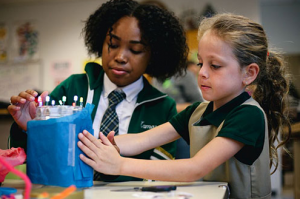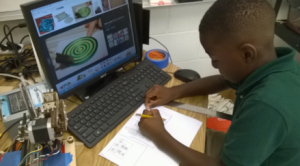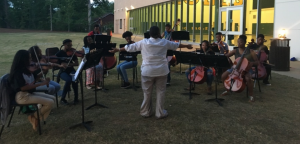by Michelle Wirth
Drew Charter School was one of the first schools in the country to start a Science, Technology, Engineering, Arts and Math (STEAM Program). The school officially began its STEAM program in 2010. Currently, the school integrates STEAM into classes in Kindergarten through the twelfth grade.
Initially, the school added arts classes to its curriculum, which already included a focus on Science,  Technology, Engineering and Math. They also held a STEAM Discovery Day. Today, the school weaves STEAM into nearly all of its classes. The school’s curriculum is standards driven but teachers decide how to best address the standards through the use of STEAM and a Project Based Learning approach.
Technology, Engineering and Math. They also held a STEAM Discovery Day. Today, the school weaves STEAM into nearly all of its classes. The school’s curriculum is standards driven but teachers decide how to best address the standards through the use of STEAM and a Project Based Learning approach.
The school hosts quarterly Maker Nights, holds robotic demonstrations and regularly brings in parents with careers in the STEAM fields for demonstrations and presentations. Students learn about computer coding, 3D printing, performance art, design thinking, film, animation, music, website construction and a number of additional STEAM-related skills and areas of study. Drew students start learning about engineering as early as Kindergarten. They even participate in the building and designing of a playground on the school’s campus called the Tinkeryard.
 Courtney Bryant, STEAM Project Manager and the Engineering Design Residency Coordinator for Drew Charter School, says incorporating the arts into its STEM curriculum is important tool to help close opportunity gaps for its students.
Courtney Bryant, STEAM Project Manager and the Engineering Design Residency Coordinator for Drew Charter School, says incorporating the arts into its STEM curriculum is important tool to help close opportunity gaps for its students.
“For many students, the arts are an entry point into something they may feel they are not good enough for, or they feel like ‘that’s for boys to do,’ or ‘that’s something for people who look different  from me to do,’” says Bryant. “We read in the news about the gender gap in STEM and the diversity gap in STEM. I want our kids to go in and blow that out of the water. I want them to feel like they own STEAM and STEM, and that they belong.”
from me to do,’” says Bryant. “We read in the news about the gender gap in STEM and the diversity gap in STEM. I want our kids to go in and blow that out of the water. I want them to feel like they own STEAM and STEM, and that they belong.”
Bryant also says adding the Arts to Science, Technology, Engineering and Math allow students to communicate STEM concepts and projects to the outside world.
 “The arts are a way to capture imagination and make your STEM vision a reality,” says Bryant. “It’s a way to communicate your message. It’s a way to get people to buy in through oral presentations, dramatic interpretation of your device or concept and through visuals that you’ve created to showcase your idea, whether that’s a film, a drawing or a three dimensional model you’ve created.”
“The arts are a way to capture imagination and make your STEM vision a reality,” says Bryant. “It’s a way to communicate your message. It’s a way to get people to buy in through oral presentations, dramatic interpretation of your device or concept and through visuals that you’ve created to showcase your idea, whether that’s a film, a drawing or a three dimensional model you’ve created.”
Drew students work on hands-on projects that cross multiple disciplines. Some of the projects they are working on this year include:
Tiny House Design and Construction
High school engineering students will design and construct a tiny house. When tasked with creating a project to solve a real world problem by Senior Academy Engineering Teacher Beth White, students decided to focus on affordable housing, which is a growing problem in the Atlanta area. The project selection came after the Atlanta City Council passed legislation to allow tiny houses in Atlanta and as the city itself works to create more affordable housing.
Once completed, the school hopes AmeriCorps members who work at the school as part of the Maker VISTA program will live in the tiny house. Currently, AmeriCorps members at Drew receive a small stipend, which typically amounts to approximately $10,000. That amount makes finding a place for AmeriCorps members to live in Atlanta difficult due to the current cost of living. Once constructed, the tiny house will be moved by a trailer and could be placed on site at the school or elsewhere in the community.
Construction of the tiny house will be funded through the Innovation Fund Tiny Grant Program through the Governor’s Office of Student Achievement, the Noyce program at Kennesaw State University and private money. Students will design the project, order the materials and build the tiny house themselves. They have to complete the project by the end of the school year.
Last year, high school students in White’s engineering class created a device intended to prevent hot car deaths. They built the device after winning a $10,000 Lemelson-MIT grant and presented their invention at the Massachusetts Institute of Technology.
Mobile Spanish Classroom
Fourth and fifth graders are helping Spanish teacher Claudia Fitzwater design a mobile classroom that will have the ability to move throughout the entire building. The project is necessary because Drew is at space capacity and the school’s Spanish teachers often have to shift rooms. The redesign will include mobile furniture and allow the class to move to the hallway, the courtyard or elsewhere throughout the building as needed. Students are currently designing the mobile classroom with the assistance of Jeff Mather, Drew’s Artist in Residence. The next step will include making prototypes and receiving community input. Students will also visit with a local furniture maker so they can better understand the furniture making process. In the final phase of the project, the students will build the classroom furniture and design other classroom items. The mobile classroom is scheduled for completion by the end of the school year.
Wax Museum of Inventors
Fifth graders are talking about famous inventors and are creating a wax museum. As part of the museum, students are building circuits in their science classes that will allow the wax figures to light up. In social studies, students are learning about the lives of the inventors. In Language Arts, fifth graders are writing monologues they will perform about the inventors.
In 2017, Drew Charter School Elementary Academy was certified as an official Science, Technology, Engineering, Arts and Mathematics (STEAM) School by the Georgia Department of Education. The school became the first school in the city of Atlanta to earn this important designation, which was recently created to recognize institutions committed to providing high-quality educational opportunities in STEAM.
“I’m incredibly proud of us for getting the certification, especially because we could have gone for STEM certification very early on because we were already doing many of the STEM certified items,” says Bryant. “Instead, we held out for the arts to be integrated into that certification because it’s so important to who we are here at Drew Charter School.”
The school also utilizes numerous partnerships to enhance its STEAM program. The Center for Education Integrating Science, Mathematics, and Computing (CEISMC) at Georgia Tech is one of those key partners. CEISMC provides professional development for the school’s teachers, presentations on robots and mathematics in the real world and evaluates the school’s grant programs. Georgia State University is another partner. Georgia State’s School of Music provides hands-on experience from professional artists. The Sound Learning Program connects music to lessons in language, arts, geography and math. Some of the school’s additional partners include: Decatur Makers, Publix and honorCode.
Ultimately, Bryant hopes students return back to the community once they’ve graduated from college to open businesses and become innovators. She says Drew Charter School helps students become critical thinkers and creative problem solvers so they are prepared for college and beyond.
